Manchester
Botanic Gardens - Old Trafford
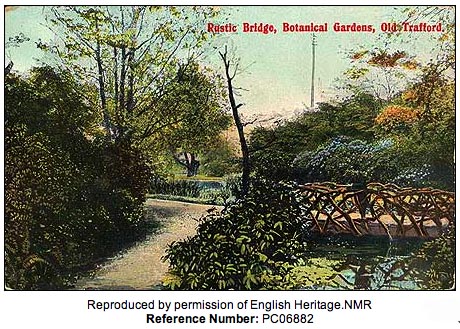

As you travel along
Chester Road in Old Trafford you will see a grand white
gateway which seems out of all proportion as a feature
of the nearby White City Retail Park.
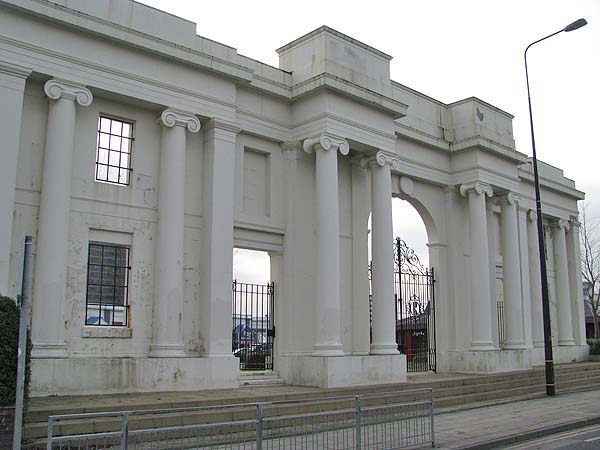
The truth is that the two are not connected. The gateway has an interesting history because it once stood as the entrance to what was described as an "Amusement Resort of the Better Class".

This was The White City Amusement Park but the story of this piece of land doesn't start there.
On this site stood the Manchester Botanic Gardens. In 1827 a meeting was held in the Old Manchester Town Hall on King Street at which the first steps were taken to form what became the Manchester Botanical and Horticultural Society. This included approval for efforts to purchase land for a botanical and horticultural garden with "proper greenhouses"
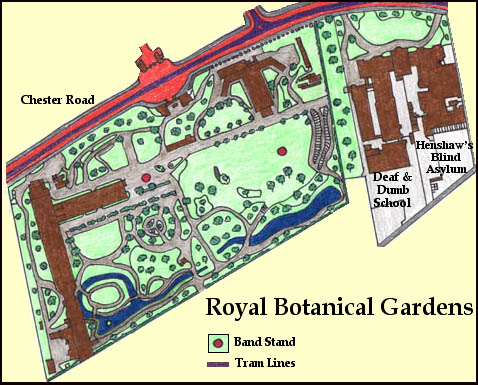
The Archive of the Royal Botanical and Horticultural Society of Manchester and the Northern Counties says of the plan: "The purpose of the Manchester Botanical and Horticultural Society was a serious one: not only to lay out gardens for the recreation of the citizens of Manchester (who would otherwise be deprived of such pleasures in the industrial city) but also to further the scientific disciplines of botany and horticulture." .... "What can be a more delightful relaxation to a Lancashire Mechanic than an hour or two in a Garden: what an escape from the pestiferous politics of the times". It must be remembered that the Peterloo Massacre had taken place a mere eight years earlier." ...."The Manchester scientist John Dalton was consulted as to the most salubrious site for a garden close to Manchester. He recommended Old Trafford, south-west of the city (the prevailing wind carried the city's airborne pollution eastward). In February 1829 sixteen acres of land in Old Trafford were conveyed by Thomas Joseph Trafford to John Holt Stanway of Manchester, for use as a botanical garden."
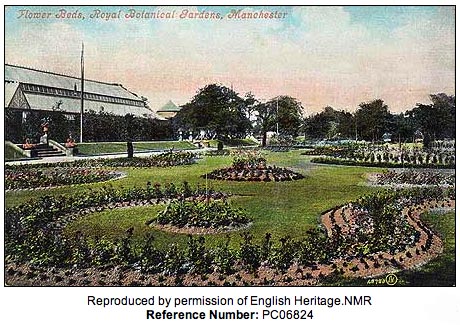
"By 1839 the gardens had matured, with fine specimens of trees and shrubs in the extensive arboretum. In the summer season exhibitions of fruits, flowers and plants proved very popular. The magnificent plant houses and conservatories extended some 321 feet in length and the domed roof of the central conservatory was forty feet high. Within were rare and beautiful specimens of plants collected from around the world. Elsewhere in the gardens were an ornamental lake, rockery, rosarium, extensive lawns, and a fruit garden with forcing houses."
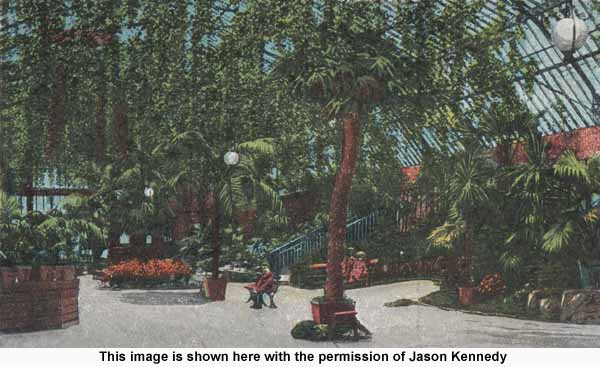
In 1857 the gardens hosted the spectacular United Kingdom Art Treasures' Exhibition, which was opened by Prince Albert. "The exhibition was staged in a vast glass-and-iron hall, resembling Paxton's Great Exhibition structure, and attracted in excess of 1.3 million visitors over a period of 142 days."

In 1887 a second exhibition was hosted by the gardens. The Exhibition of Art, Science and Industry was held there during Queen Victoria's Golden Jubilee. The main building, which was designed by Maxwell & Tuke, was cross-shaped and measured 1000 feet in length, with a central dome 140 feet high. This exhibition lasted 192 days and some 4.75 million people attended.


The truth is that the two are not connected. The gateway has an interesting history because it once stood as the entrance to what was described as an "Amusement Resort of the Better Class".

This was The White City Amusement Park but the story of this piece of land doesn't start there.
On this site stood the Manchester Botanic Gardens. In 1827 a meeting was held in the Old Manchester Town Hall on King Street at which the first steps were taken to form what became the Manchester Botanical and Horticultural Society. This included approval for efforts to purchase land for a botanical and horticultural garden with "proper greenhouses"

The Archive of the Royal Botanical and Horticultural Society of Manchester and the Northern Counties says of the plan: "The purpose of the Manchester Botanical and Horticultural Society was a serious one: not only to lay out gardens for the recreation of the citizens of Manchester (who would otherwise be deprived of such pleasures in the industrial city) but also to further the scientific disciplines of botany and horticulture." .... "What can be a more delightful relaxation to a Lancashire Mechanic than an hour or two in a Garden: what an escape from the pestiferous politics of the times". It must be remembered that the Peterloo Massacre had taken place a mere eight years earlier." ...."The Manchester scientist John Dalton was consulted as to the most salubrious site for a garden close to Manchester. He recommended Old Trafford, south-west of the city (the prevailing wind carried the city's airborne pollution eastward). In February 1829 sixteen acres of land in Old Trafford were conveyed by Thomas Joseph Trafford to John Holt Stanway of Manchester, for use as a botanical garden."

"By 1839 the gardens had matured, with fine specimens of trees and shrubs in the extensive arboretum. In the summer season exhibitions of fruits, flowers and plants proved very popular. The magnificent plant houses and conservatories extended some 321 feet in length and the domed roof of the central conservatory was forty feet high. Within were rare and beautiful specimens of plants collected from around the world. Elsewhere in the gardens were an ornamental lake, rockery, rosarium, extensive lawns, and a fruit garden with forcing houses."

In 1857 the gardens hosted the spectacular United Kingdom Art Treasures' Exhibition, which was opened by Prince Albert. "The exhibition was staged in a vast glass-and-iron hall, resembling Paxton's Great Exhibition structure, and attracted in excess of 1.3 million visitors over a period of 142 days."

In 1887 a second exhibition was hosted by the gardens. The Exhibition of Art, Science and Industry was held there during Queen Victoria's Golden Jubilee. The main building, which was designed by Maxwell & Tuke, was cross-shaped and measured 1000 feet in length, with a central dome 140 feet high. This exhibition lasted 192 days and some 4.75 million people attended.

The end for the
Botanic Gardens came in 1907 when declining public
interest and the reluctance of the city council to
support it financially resulted in the site being
leased to the White City Limited and to hear what
happened next you need to choose White City from the
menu opposite.